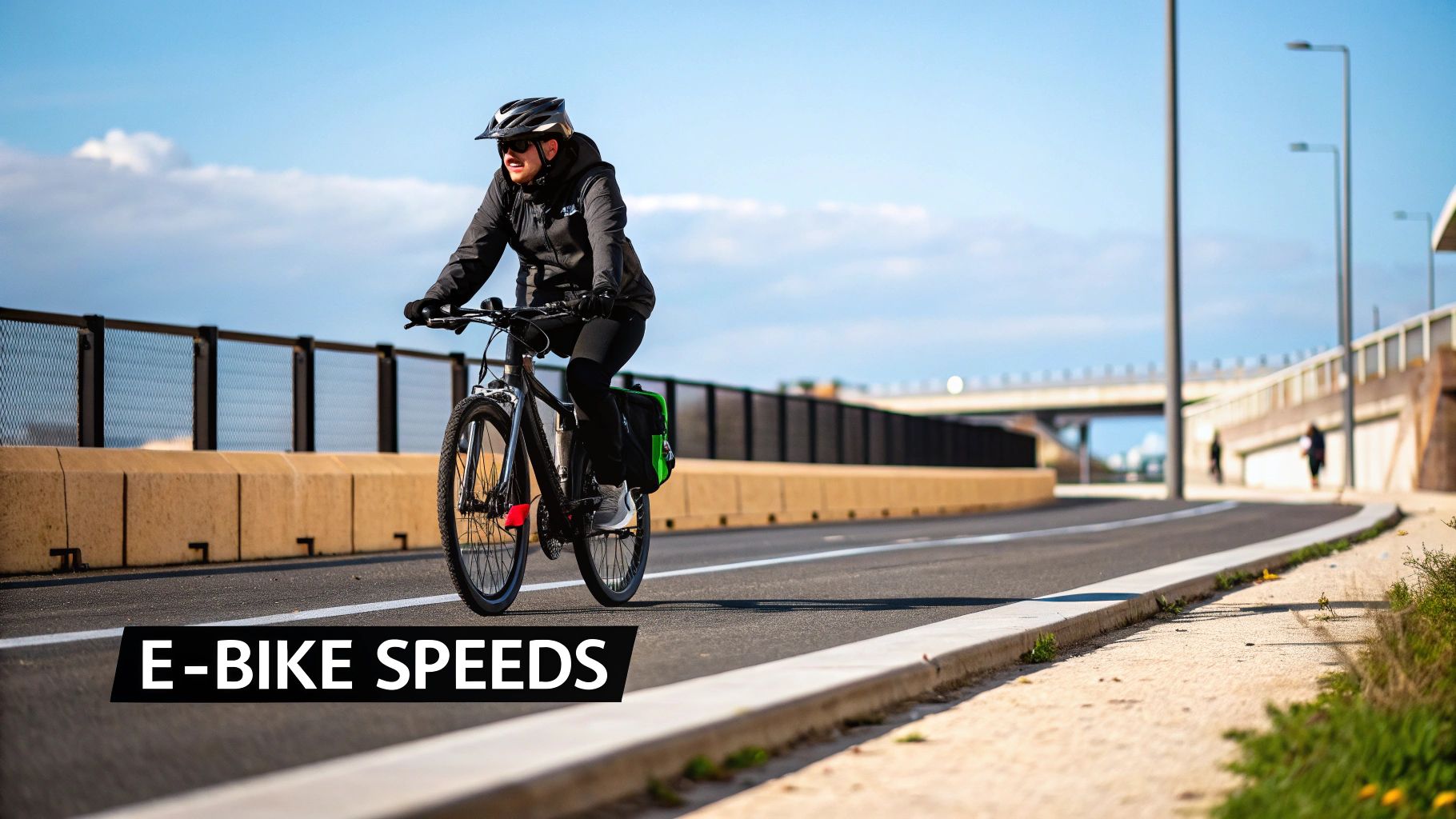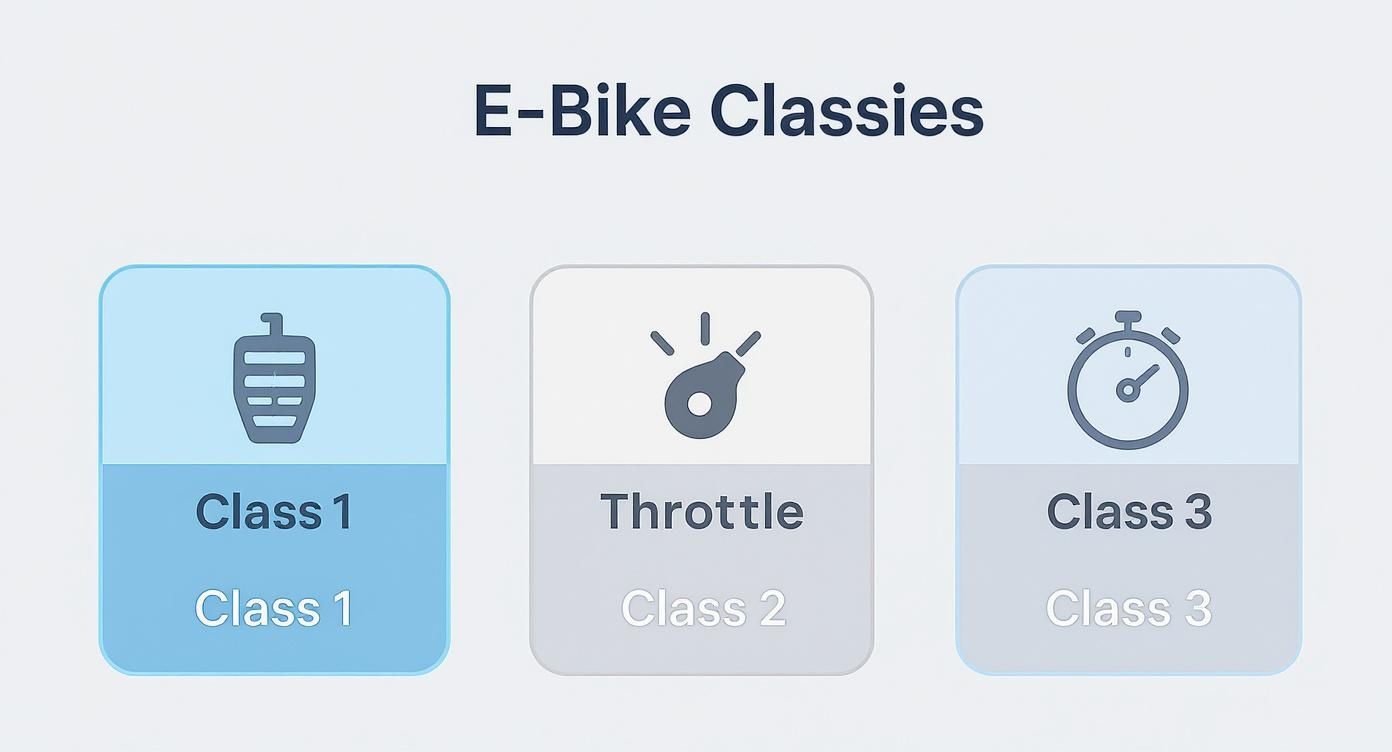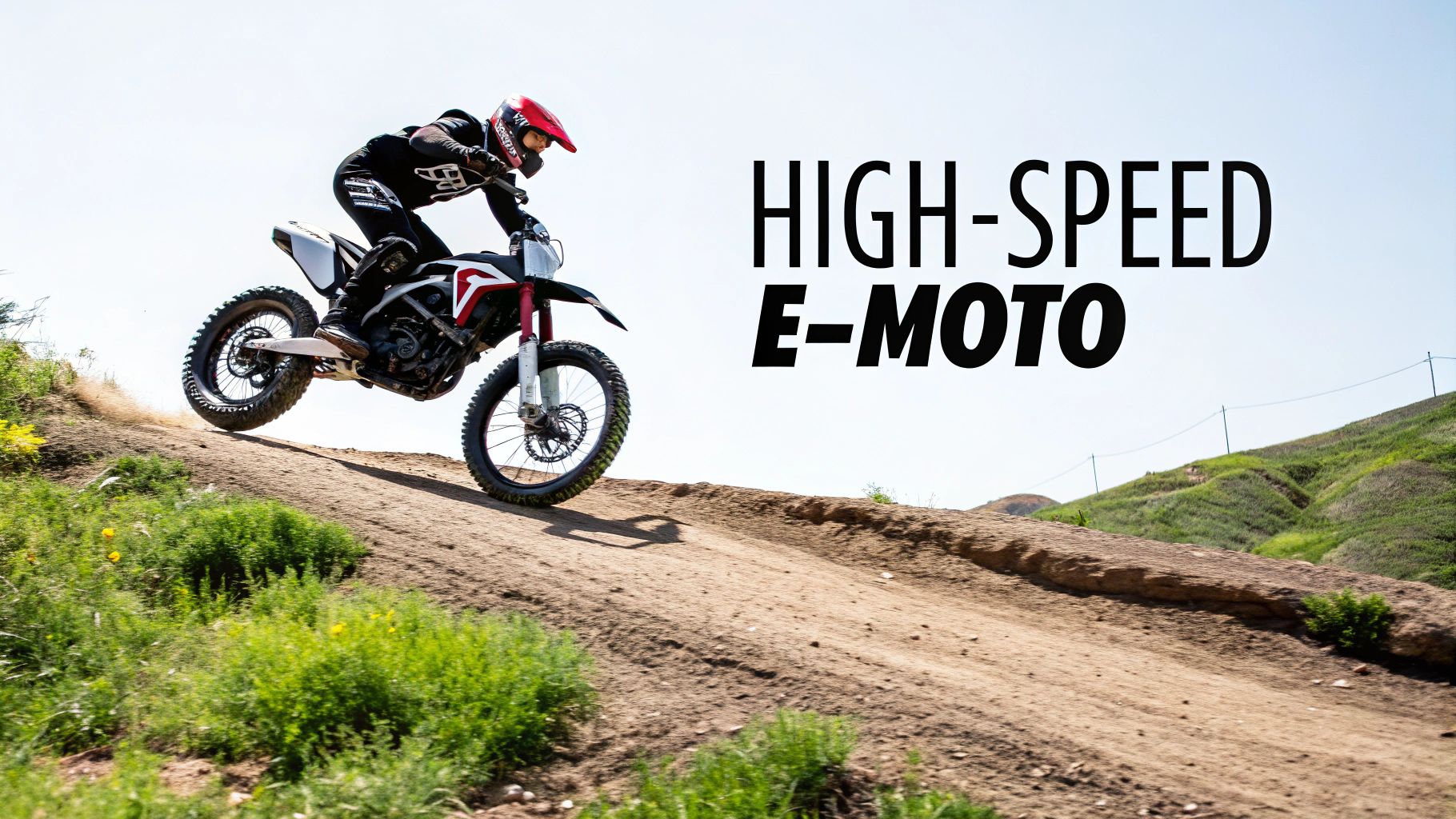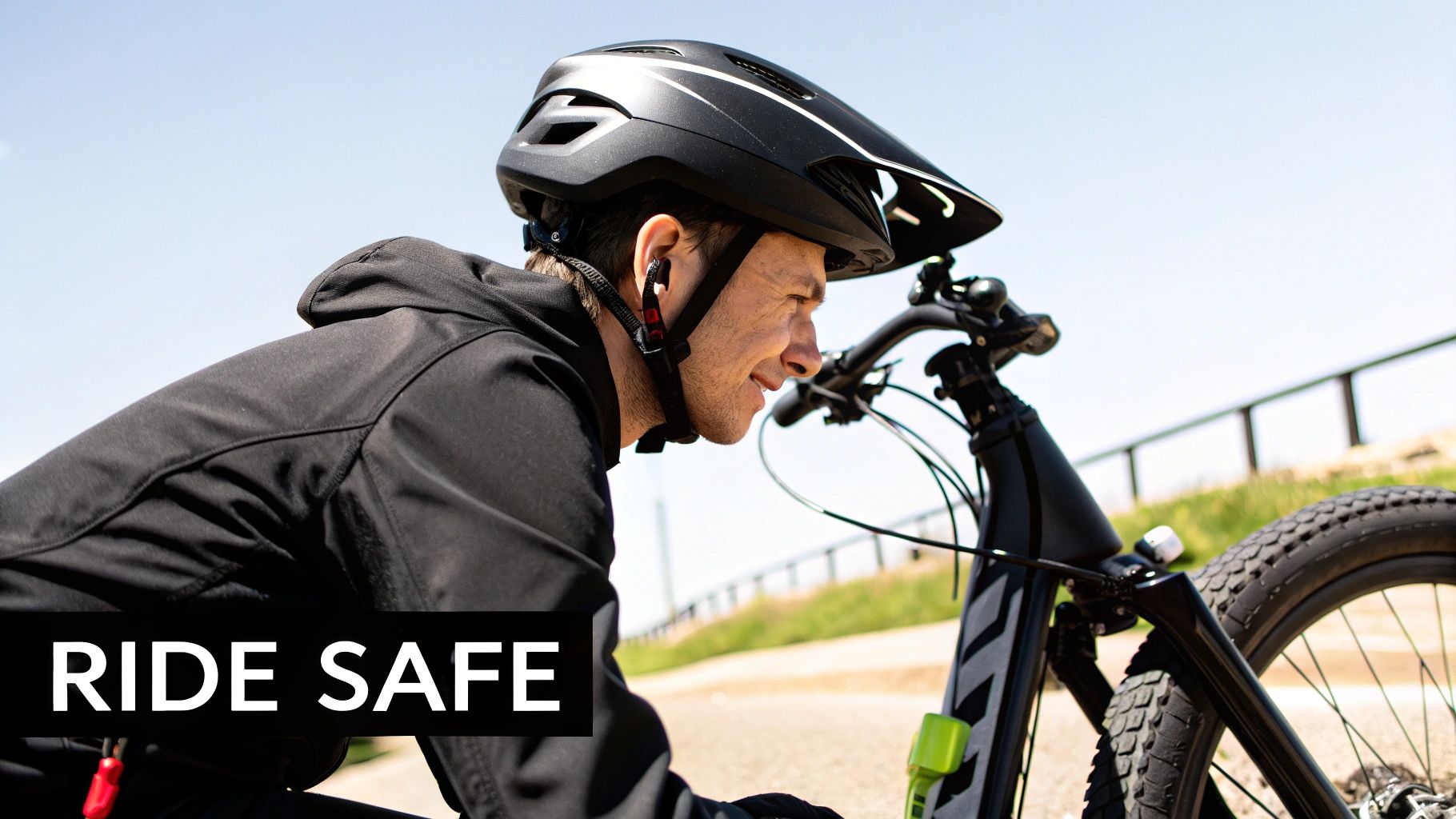Most street-legal e-bikes you'll see on the road top out somewhere between 20 and 28 mph with motor assistance. But that’s just part of the story. Think of an e-bike's speed not as a single number, but as a range—one that’s shaped by its legal class, its hardware, and where and how you’re riding it.
Let's break down what that really means for you out on the road.
Unlocking Your E-Bike's Speed Potential

So, how fast do electric bikes actually go? The answer is a bit more complex than you might think, starting with a legal framework designed to keep riders and pedestrians safe. In the early days, things were a bit like the Wild West, but now established regulations define what an e-bike can and can't do.
For example, both Class 1 and Class 2 e-bikes are typically capped at 20 mph (32 km/h), while the zippier Class 3 models can get you up to 28 mph (45 km/h), but only while you're pedaling. You can find more details about e-bike speed classifications on isinwheel.co.uk.
These classifications are the foundation for everything, giving you a clear idea of what to expect straight out of the box.
The Three Tiers of Speed
To really get a handle on e-bike speed, the best place to start is the class system. It’s a simple set of rules that manufacturers follow and helps riders know what they’re buying.
Here’s a quick overview of the most common e-bike classes and their typical speeds.
E-Bike Speed at a Glance
| E-Bike Class | Maximum Assisted Speed | How it Works |
|---|---|---|
| Class 1 | 20 mph | Pedal-assist only; the motor helps only when you pedal. |
| Class 2 | 20 mph | Pedal-assist plus a throttle for power on demand. |
| Class 3 | 28 mph | Pedal-assist only, but at a higher top speed. |
This table gives you a solid baseline for what to expect from most commercially available e-bikes. Let's dig a little deeper into what each class feels like to ride.
Class 1: The All-Rounder
These bikes are the most common and widely accepted. The motor gives you a boost, but only when you're pedaling, and it cuts out once you hit 20 mph. Because of this, they’re usually allowed on the same bike paths and trails as regular bicycles. Simple and effective.
Class 2: The Cruiser
Class 2 bikes also top out at 20 mph, but they have a secret weapon: a throttle. This means you can get a push from the motor without pedaling at all. It’s perfect for getting started from a dead stop or for those moments when you just want to cruise and enjoy the ride.
Class 3: The Commuter's Choice
Built for getting around town quickly, Class 3 e-bikes keep assisting you all the way up to 28 mph. This extra speed is a game-changer for commuters who want to keep up with city traffic. The catch? They are often pedal-assist only (no throttle at those higher speeds) and may face more restrictions on bike paths and multi-use trails.
Understanding these classes is the first step to choosing a bike that matches your riding style and local regulations. A faster bike isn't always better if you can't ride it where you want to go.
Of course, the world of e-bikes doesn't stop there. You'll find high-performance, off-road e-bikes and e-motos that can blow past 60 mph. Just remember, those beasts aren't street-legal and are meant strictly for private property.
Understanding the E-Bike Class System
Before we can talk about how fast an electric bike can go, we need to get on the same page about the e-bike class system. Think of it less like a technical manual and more like a simple set of rules that defines what a bike can do and, crucially, where you can legally ride it.
This isn't just industry jargon; it's the key to figuring out which bike fits your life. In the U.S., e-bikes are generally grouped into three main classes. These categories are all about two things: the bike's top assisted speed and whether it has a throttle. Getting this right is the first step to finding the perfect ride.
Class 1: The Trail-Friendly Companion
A Class 1 e-bike is the most common and widely accepted type you'll find. It's often welcome on the same bike paths and trails as regular, non-electric bikes.
The motor on a Class 1 only kicks in when you're actively pedaling—a system called pedal-assist. Once you hit 20 mph, that assistance gracefully fades out. This makes it perfect for riders who love the feeling of cycling but want a helpful nudge on tough hills or long distances. It feels like you’ve suddenly been gifted with superhuman legs.
Want to get into the nuts and bolts of this system? You can learn more about how pedal-assist e-bikes work to see if it’s what you're looking for.
Class 2: Effortless Power on Demand
Just like a Class 1, a Class 2 e-bike tops out at 20 mph of motor assistance. The game-changing difference? It has a throttle. This little feature lets you power the bike forward without pedaling at all.
That throttle makes Class 2 bikes incredibly practical. It's perfect for getting a quick, zippy start from a standstill at a traffic light or for just cruising along and taking a break from pedaling. You get the best of both worlds: a moped-like experience when you want it and a great workout when you don't.
With a throttle, you get instant acceleration right at your fingertips. It's why Class 2 bikes are a huge hit with commuters and anyone who just wants a fun, flexible ride.
Class 3: The Speedy Commuter
If your goal is to keep up with city traffic and slash your commute time, the Class 3 e-bike is your machine. These are the speed demons of the street-legal e-bike world, offering pedal assistance all the way up to a zippy 28 mph.
Because they're faster, Class 3 bikes come with more rules. You'll often find they're restricted from multi-use paths, and many areas require riders to be a certain age or wear a helmet. To keep things safe, most Class 3 bikes are pedal-assist only—if they have a throttle, it typically cuts out at 20 mph. This ensures you’re actively engaged and in control when moving at higher speeds.
What Really Determines Your E-Bike's Speed
While the official class system gives you a baseline for an e-bike's speed limit, it’s far from the whole story. A handful of real-world factors work together to decide how fast you'll actually go on any given ride. Getting to know these elements helps you see past the sticker on the bike and understand how it will really perform for you.
The Bike's Core Components
Think of an e-bike's motor as its engine. Measured in watts (W), the motor's power rating tells you a lot about its ability to accelerate and tackle hills. A typical commuter e-bike might have a 250W or 500W motor, which is more than enough for cruising around town.
However, more powerful 750W motors, like the ones we use on some eBike Gang models, deliver a serious boost in torque. That means faster acceleration from a standstill and the muscle to maintain speed when the road starts to climb.
The battery is the bike's fuel tank. Its voltage (V) and amp-hours (Ah) determine how much power it can feed the motor and for how long. A higher-voltage battery, like a 48V or 52V system, sends power to the motor more efficiently. This helps it reach—and hold—its top speed without feeling strained. It's a crucial part of the performance puzzle, and our in-depth electric bike buying guide breaks down exactly how to match battery specs to your riding style.
It's Not Just the Bike—It's You and the Road
Beyond the bike's hardware, your environment and even you as the rider play a huge part in your actual speed. These variables can easily add up to a noticeable difference in performance from one day to the next.
One of the biggest factors is your total weight—that includes you, your bike, and anything you're carrying. A heavier load forces the motor to work harder, which can slow down both acceleration and your top speed, especially on hills. Lighter setups will almost always feel peppier and hit their max speed with less effort.
This chart breaks down the key differences between the three main e-bike classes, showing how each one uses its motor to help you ride.

It’s a great visual for understanding the fundamental split between pedal-assist, throttle control, and the higher speed potential of Class 3 bikes.
The Impact of Terrain and Conditions
The surface you’re riding on has a direct impact on how fast you can go. Smooth, paved roads offer the least resistance, letting you zip along and hit top speeds easily. But once you move onto gravel, dirt, or even grass, the increased friction forces the motor to put in more work, usually resulting in a lower top speed.
The table below shows how different variables can either help or hinder your e-bike's performance.
How Different Factors Impact E-Bike Speed
| Factor | Impact on Speed | Real-World Example |
|---|---|---|
| Motor Power | Increase | A 750W motor accelerates faster and holds speed on hills better than a 250W motor. |
| Rider & Cargo Weight | Decrease | Adding 40 lbs of groceries will make your bike feel noticeably slower, especially uphill. |
| Uphill Terrain | Decrease | A steep hill can cut your speed in half as the motor fights gravity. |
| Downhill Terrain | Increase | You can easily coast past your bike's 28 mph assisted limit on a long, steep descent. |
| Headwind | Decrease | Riding into a strong 15 mph wind can feel like a constant uphill battle, reducing your speed. |
| Tire Pressure | Increase (when optimal) | Properly inflated tires roll with less friction, adding 1-2 mph to your top speed on flat ground. |
As you can see, it’s a combination of forces at play. A powerful motor might be canceled out by a heavy load and a stiff headwind, while a simple tailwind can make you feel like a pro cyclist. Understanding this balance is key to getting the most out of your e-bike.
Stepping into the World of Off-Road and High-Speed E-Bikes

While the e-bike world you see on city streets is neatly defined by Class 1, 2, and 3 regulations, there's a whole other breed of machine built to completely demolish those speed limits. These are the high-performance off-road e-bikes, often blurring the line into what we call "e-motos." They leave the 28 mph speed cap in the dust.
Forget about your daily commuter. These are highly specialized bikes built for one thing: performance. They're designed exclusively for private land, closed race courses, and dedicated off-road parks. Think of them as a potent cocktail—mixing the nimble, lightweight feel of a mountain bike with the raw, exhilarating power of a dirt bike.
What Makes These E-Bikes So Different?
The most glaring difference is the motor. A street-legal e-bike typically has a motor rated somewhere between 250W and 750W. The power plants on these off-road beasts? They're often measured in the thousands of watts. That massive power jump translates directly into face-melting acceleration and truly staggering top speeds.
Of course, all that power requires a bike built to handle it. You'll find beefy, reinforced frames, long-travel suspension that can soak up huge jumps and drops, and massive hydraulic disc brakes that can stop a machine moving at motorcycle speeds. They are engineered from the ground up for extreme abuse, not for a gentle cruise on the bike path.
The most important thing to remember is the legal distinction. While these machines are the absolute pinnacle of electric performance, they are not legal for use on public roads, sidewalks, or bike lanes. They are purpose-built vehicles meant for controlled, off-road environments only.
How Fast Are We Talking?
So, how fast can an electric bike really go when you remove the legal limiters? The numbers are genuinely eye-watering. It's not uncommon for production models to comfortably hit speeds of 60 mph or more, launching them into a performance category that has nothing in common with a traditional e-bike.
A few elite models push the envelope even further. The Hallomotor FC-1, for instance, is capable of reaching 68 mph (110 km/h). Even more extreme, the Hi Power Cycles Revolution X9 has been clocked at an astonishing 75 mph (120 km/h), making it one of the fastest production e-bikes ever built. You can dive deeper into these incredible high-speed e-bikes on emountainbikekings.com.
These machines aren't just fast; they represent the frontier of e-bike technology. They’re a thrilling testament to what electric motors can do when engineers are free to chase pure, unadulterated speed and off-road dominance.
Their existence also highlights a crucial part of the e-bike ecosystem. While most of us enjoy the practical, everyday benefits of Class 1-3 bikes, there's an entire community of riders and engineers constantly pushing the limits. The innovation happening in this high-performance space—from more efficient motors to better battery tech—often trickles down and benefits the entire industry.
Staying Safe at Higher E-Bike Speeds

Let’s be honest, cruising along at 28 mph is a blast. But with great speed comes great responsibility. Just like a race car driver needs more than a fast car to win, an e-bike rider needs the right gear and smart habits to stay safe and in control. It's not just about protecting your bike; it's about protecting yourself.
This is more important than ever as the e-bike world explodes in popularity. The market was valued at a whopping USD 43.59 billion in 2023 and is expected to rocket to USD 148.70 billion by 2032. Why the boom? A big part of it is speed—some e-bike trips are a full 21% quicker than the same journey on a regular bicycle. You can dive deeper into the growth of the electric bike market on fortunebusinessinsights.com.
With so many of us riding faster, safety has to be a top priority for everyone.
Your Non-Negotiable Safety Gear
When you start asking how fast an e-bike can go, your very next question should be, "how well does it stop?" The single most critical safety feature on any fast e-bike is a solid set of brakes.
Hydraulic disc brakes are the gold standard here. They deliver powerful, reliable stopping power in wet or dry conditions, which is exactly what you need when you have to scrub off speed in a hurry.
Next on the list is your helmet. For the speeds you'll hit on a Class 3 bike, a standard bicycle helmet is the absolute minimum. But a lot of savvy riders are upgrading to helmets with an NTA 8776 certification. This is a newer standard specifically designed for the higher impact speeds associated with e-biking, giving you that extra layer of protection.
Pre-Ride Checks for a Safer Journey
Before you head out, a quick two-minute once-over can catch most common mechanical problems before they start. Think of it as a pilot’s pre-flight check, but for your bike.
Run through this simple checklist:
- Tires: Give them a squeeze. Are they properly inflated? The right pressure is key for good grip and handling.
- Brakes: Pull both brake levers. They should feel firm and responsive, not spongy.
- Chain: Glance at your chain. Any rust or stiff links? A clean, lubed chain runs smoothly and efficiently.
- Lights: If your bike has them, flick them on and off to make sure they're working. Visibility is safety.
Taking these few simple steps builds your confidence and ensures your bike is ready for whatever the ride throws at you. For a more detailed breakdown, check out our complete guide on essential electric bike safety tips. A little routine maintenance and a safety-first mindset are all it takes to enjoy the thrill of speed with total peace of mind.
Common Questions About E-Bike Speed
As you dive into the world of e-bikes, a few key questions about speed and regulations always pop up. Let's tackle some of the most common ones head-on so you can ride with confidence.
Can You Remove an E-Bike Speed Limiter?
This is a big one. Technically, yes, you can find ways to "unlock" or bypass the speed limiter on most e-bikes. But should you? Absolutely not.
Right off the bat, doing this will void your warranty. More importantly, it pushes the motor, battery, and controller far beyond what they were designed for, leading to a much shorter lifespan and potential failures. Think of it like redlining a car engine constantly—something is bound to break.
Beyond the mechanical risks, you're also stepping into a legal gray area. An unlocked e-bike is no longer a Class 1, 2, or 3 e-bike; it's often reclassified as an unlicensed motor vehicle. This could land you with hefty fines and puts you and others at serious risk on public roads and trails. It’s simply not worth it.
Do You Need a License for a Fast E-Bike?
For any standard Class 1, 2, or 3 e-bike, the answer is generally no. In most places across the US, they are treated just like regular bicycles, meaning you don't need a special license, registration, or insurance to ride them.
The moment you modify your bike to go faster than its class limit, though, the rules change. That "e-bike" might now legally be considered a moped or even a motorcycle, which comes with all the standard requirements: license, registration, and insurance. Always double-check your local state and city laws to stay on the right side of the law.
How Fast Can E-Bikes Go Downhill?
This is where physics takes over. Your e-bike’s motor will stop helping you once you hit its speed limit—say, 28 mph for a Class 3 bike. But that doesn't mean the bike stops accelerating.
When you're heading down a steep hill, gravity is in the driver's seat. Your speed is now only limited by air resistance, the friction of your tires, and your nerve on the brakes. It's not at all unusual for riders to hit 40 mph or even faster on a good descent. This is exactly why having a set of powerful, well-maintained brakes isn't just a feature; it's a critical safety requirement.
Ready to experience the perfect blend of speed, power, and reliability? Explore the full range of electric bikes and dirt bikes at eBike Gang and find the model that’s built for your next adventure. Check out our collection at https://ebikegang.com.

